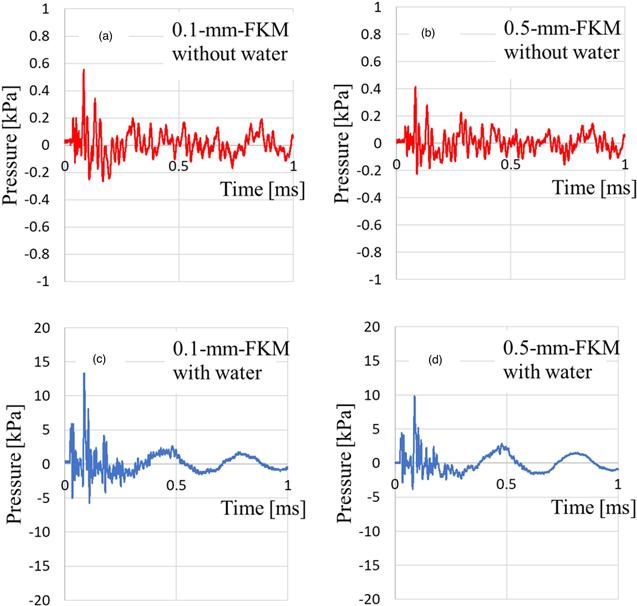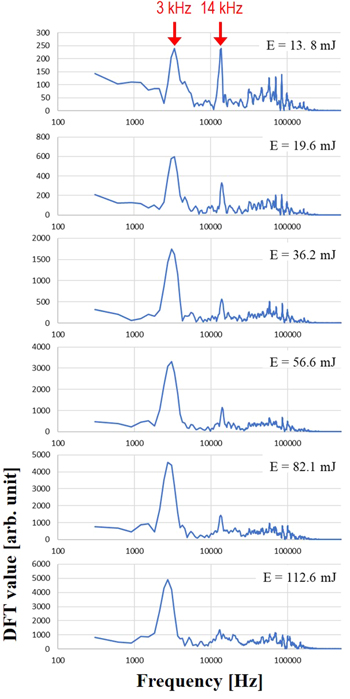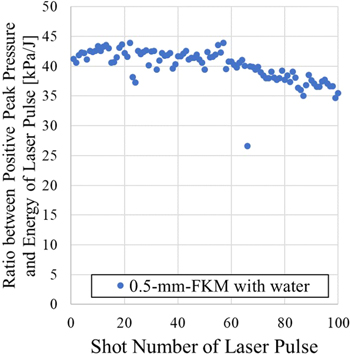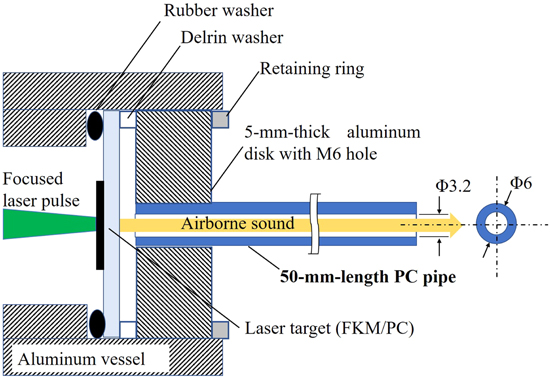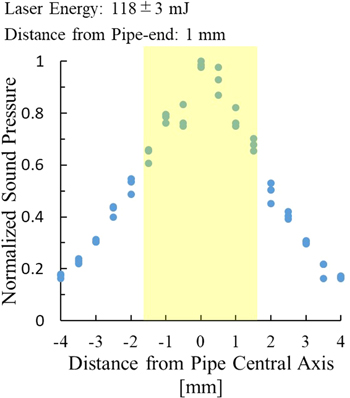Abstract
A high-intensity and small-size laser-induced airborne sound source was developed for application to non-contact and non-destructive testing. A laser target composed of a polycarbonate (PC) plate and a black fluoro-rubber (FKM) film immersed in circulating water was used as the sound source. The maximum sound pressure of about 15.2 kPa was obtained at a distance of about 11 mm from the surface of the laser target when a pulsed laser with its energy of about 110 mJ was irradiated to a 0.1 mm thick FKM film immersed in circulating water. The ratio of maximum pressure to the irradiation energy was stabilized up to 60 shots of pulsed laser irradiation. The maximum sound pressure of about 18 kPa was obtained through the 50 mm length cylindrical PC pipe of 3.2 mm in diameter when a pulsed laser at an energy of 120 mJ was irradiated to a 0.5 mm thick FKM film immersed in circulating water.
Export citation and abstract BibTeX RIS
1. Introduction
Ultrasonic testing, which uses ultrasonic waves, is well known as a non-contact, non-destructive inspection, 1) and the laser ultrasonic method is one of the most representative of several methods. 2–8) In this method, a laser beam is irradiated onto the test specimen to generate elastic waves, which are detected in a non-contact manner. Therefore, this method cannot be applied to specimens that do not absorb laser light. A non-contact ultrasonic method that does not depend on the properties of the specimen is the airborne ultrasonic method, in which ultrasonic waves are transmitted and received through the air surrounding the specimen. 9–11) In this airborne ultrasonic method, the received signal strength is extremely weak in general and high sensitivity of the receiving element is needed. However, the use of a powerful airborne ultrasonic source is also effective at the same time.
A bolt-clamped Langevin-type (BLT) transducer has been investigated as a powerful airborne ultrasonic source. 12–14) Ito et al. reported the generation of strong aerial ultrasonic waves of 15 kPa as an estimated value in a point-converging source consisting of a deflection diaphragm connected to a BLT and a rotating parabolic reflector. 15) High-intensity airborne ultrasound is used for many applications such as surface cleaning, 16) atomization, 17,18) liquid removal, 19–21) gas removal, 22) non-contact excitation, 23) internal defect detection, 24,25) damage detection, 26,27) surface monitoring, 28) impregnation, 29) drying, 30) and agglomeration. 31) On the other hand, a different approach is the idea of using powerful laser ultrasound as an airborne ultrasonic source with high intensity and small size.
In general, when a medium is irradiated with an intermittent light, elastic waves are generated by the photoacoustic effect. 32) When the intense laser light is irradiated to the medium, ablation plasma is generated and expands at the surface of the medium, 33) moreover, the elastic wave intensity is enhanced when the medium transparent to the laser light is covered with the surface. 34) In this case, it has been reported that elastic waves exceeding 100 MPa are induced and propagated in the solid medium. 35) If a short-pulse laser is used as a light source, pulsed elastic waves with frequency components of ultrasound are induced in the medium, and then a part of the elastic wave energy is radiated toward the air in contact with the medium.
We have previously reported that sound pulses with maximum sound pressure exceeding 15 kPa were emitted to air when a black rubber thin film covered with transparent resin was irradiated with a laser pulse with an incident energy of 125 mJ focused at a diameter of about 3 mm. 36,37) However, it is found in this experiment, stable and continuous generation of the airborne sound pulse is impossible due to residual plasma pressure and catastrophic damage to the laser target. When black ink was used as a laser target, we found that an airborne sound pulse was radiated in response to the pulsed laser irradiation to black ink flow through the transparent tube. 38) In this case, however, thermal damage to the transparent medium is one of the serious problems.
Recently, we have introduced circulating water as the transparent medium used to solve some problems caused by residual plasma pressure and thermal damage to the transparent medium. 39) It has known that plasmas induced by liquid-phase laser ablation have a high-pressure of 1 GPa. 40) Therefore, if a pulsed laser is applied to an optical absorber immersed in circulating water, it suggests that high-intensity airborne sound can be generated by high-pressure laser plasma formation. In this study, we investigated the sound pressure variation of airborne sound generated when a laser target immersed in circulating water was irradiated with a pulsed laser in detail. To obtain an intense pressure pulse far away from the laser target, propagation through a cylindrical pipe was also investigated.
2. Experimental procedure
2.1. Preparation of circulating water-immersed optical absorber
In this experiment, a surface black anodized aluminum vessel was prepared to be filled with circulating water between the focusing lens and the surface of the optical absorber. A cross-sectional illustration inside the aluminum vessel is shown in Fig. 1. The focusing lens (Sigma, SLM-30-100PM) used a convex lens with a non-reflective surface to visible light, and then the pulsed laser through its lens was irradiated to an optical absorber. An optical absorber was bonded with epoxy resin on an impact-resistant plastic plate. A 1 mm thick polycarbonate (PC) disk of a diameter of 30 mm was used as a plastic plate. One of the optimal materials for light absorbers is black rubber. Because fluoro-rubber (FKM) is one of the promising elastomers which can be obtained with a thin film, the black FKM of either 0.1 mm or 0.5 mm thick film was used as an optical absorber. In this study, the structure combined an FKM film and PC plate called a "laser target." To prevent water leakage, the focusing lens and laser target were fixed to the aluminum vessel with the sealing gaskets consisting of rubber and Delrin washers by the retaining ring (Sigma, RR-30-5). In addition, a 5 mm thick aluminum disk with an M6-drilled-hole was inserted between the Delrin washer and the retaining ring. The distance between the focusing lens and the laser target was kept at 80 mm, and then the focusing lens with a focal length of 100 mm was used. The inner diameter of the aluminum vessel is 20 mm, but the inner diameter at the midpoint between the focusing lens and the laser target is narrowed to 10 mm for the prevention of underwater shock waves generated by the laser irradiation destroying the focusing lens. The generated shock wave reflects inside the aluminum vessel and returns to the target containing the FKM film. We consider that part of the shock wave energy returned to the target is radiated into the air. This circulating water is supplied from the focusing lens side and discharged from the laser target side. The water volume inside the aluminum vessel is approximately 20 ml, and the flow rate of circulating water is 3.7 l min−1. Pure water circulates inside the aluminum vessel through a radiator cooled by a fan. The water temperature varied between 20 °C and 30 °C, depending on the room temperature. This configuration enables the confinement of the ablation plasma during laser irradiation, removal of bubbles generated on the target surface, and cooling of the target. The laser-generated elastic waves propagate into the laser target, and then the airborne sound waves emitted from the target surface pass through an M6-drilled hole.
Fig. 1. (Color online) An experimental illustration in which the cavity between the laser target and the focusing lens is filled with circulating water. Airborne sound is radiated to air through a laser target when a pulsed laser is irradiated to the target surface.
Download figure:
Standard image High-resolution image2.2. Laser optics and sound measurement system
Figure 2 shows a schematic diagram of the laser optics and airborne sound measurement system. A second harmonic pulse light (wavelength 532 nm, pulse width 10 ns) of a Q-switch Nd:YAG laser (Spectra-Physics, LAB-130-10) is irradiated through the convex lens onto the FKM surface of a laser target. The area of the laser irradiation on the FKM surface immersed in circulating water was approximately 5 mm2. On the other hand, the irradiating area was as small as approximately 1.7 mm2 when the FKM surface was exposed to air, that is, without circulating water. The energy of the laser beam emitted from the laser system is separated by a beam sampler (Sigma, BS4-30C03-10-550) and measured by an energy detector (Gentic, QE25LP-D-MB-QED-DO). From the detected values, the laser energy incident on the convex lens was calculated using the results of a previously determined calibration, and this calculated value was used as incident energy. The emitted airborne sound waves were detected by a 1/8-inch size pressure microphone set (G.R.A.S., 46DE, bandwidth 6.5 Hz to 140 kHz) placed on the central axis of the M6-dilled-hole. The reflection of sound waves between the aluminum disk and the microphone diaphragm may occur, however, we consider that the effect of reflected waves can be ignored because the reflective surface is located away from the central axis. This microphone set consists of a pressure microphone and a preamplifier, and has a low sensitivity and small size for high-level and high-frequency measurements. This microphone connected to a constant-current input module with an unloaded constant-current-power supply (G.R.A.S., 12AL) has a sensitivity of 0.71 mV Pa−1 at the frequency of 250 Hz. The signal from this microphone is monitored by a digital oscilloscope (Iwatsu, DS-5654A or DS-5414) synchronized with the Q-switch trigger signal from the laser system. The sample rate and the record length of the signal measurements were 10 MS s−1 and 10 K points, respectively.
Fig. 2. (Color online) A schematic diagram of the laser optics and airborne sound measurement system.
Download figure:
Standard image High-resolution image3. Experimental results and discussion
3.1. Pressure waveforms and maximum sound pressure
Figure 3 shows typical sound pressure waveforms emitted through a laser target composed of either a 0.1 mm or 0.5 mm thick FKM film and a 1 mm thick PC plate with and without circulating water when a single laser pulse was irradiated to the FKM film. A laser target without circulating water is constantly exposed to air in the experiment. Since the sound pressure in the vicinity of the M6-hole drilled in the aluminum disk was expected to be larger than 50 kPa, which exceeds the detection limit of the microphone, the microphone tip was placed 5 mm from the surface of the aluminum disk. In this case, the distance between the outer surface of the laser target and the microphone tip was kept at about 11 mm. The incident laser pulse energy of about 110 mJ and 130 mJ were used in the experiments with and without circulating water, respectively. From these results, the first arrival was composed of several pulse-like waves. The experiments with circulating water also showed an oscillating waveform over a long period. It was found that the first pulsed wave arrived about 30 μs after laser irradiation. The sound pressure measured at 45 degrees direction from an M6-hole was about 0.42 times (−7.6 dB in SPL) lower than that at 0 degrees. Since this decrease is larger than that for the assumed spherical wave, the sound wave radiated from the hole is considered to be directional. Moreover, the other pulsed wave also showed after about 90 μs and its sound pressure was highest. It has been reported that a laser-induced stress wave shows a positive polarity pulse when a pulsed laser is irradiated to the target surface covered with a transparent material. 35) Therefore, it seems that the pulsed waves obtained in the present results are attributed to the stress wave generated inside the laser target by the pulsed laser irradiation. Since the second pulsed wave was observed even without the aluminum disk attached to the laser target, we supposed that the elastic waves propagating inside a laser target originated the airborne sound generation. Although we have not observed specific vibration, it has been reported that pulsed laser ablation causes impulse excitation. 41,42) If the laser-irradiated surface acts as an oscillating piston, the resulting sound field is derived from plane and edge waves. 43) Based on the estimation of propagation time, the first arrival wave seems to derive from a plane wave propagating normal to the surface of the PC plate. On the other hand, the second arrival wave seems to have been strengthened by overlapping the edge waves parallel to the PC plate.
Fig. 3. (Color online) Typical pressure waveforms of laser-induced airborne sound. The black fluoro-rubber films with the thickness of (a), (c) 0.1 mm and (b), (d) 0.5 mm are used as an optical absorber. The target surface is either (a), (b) exposed to air or (c), (d) immersed in circulating water.
Download figure:
Standard image High-resolution imageFigure 4 shows the maximum sound pressure estimated from the measured waveforms. The mean value and standard deviation of the maximum sound pressure were determined after five single laser pulse exposures to each experiment. The distance between the outer surface of the laser target and the microphone tip was kept at about 11 mm. It was revealed from these results that the maximum sound pressure reached 15.2 ± 0.2 kPa when the 0.1 mm thick FKM film immersed in circulating water was used. This maximum value was about 36 times higher than that when the FKM film was exposed to air. We attribute this result to an increase in elastic wave intensity due to the confinement effect of the ablation plasma. 34) The maximum sound pressure of the laser target using a 0.1 mm thick FKM film became about 1.5 times higher than that using a 0.5 mm thick FKM film when the circulating water was used. In an experiment about only FKM film without circulating water, sound pressure values decreased with thicker FKM film. This suggests acoustic attenuation in the FKM film.
Fig. 4. (Color online) Dependence of average maximum sound pressure (each 5 trials) on rubber thickness. The mean value and standard deviation are shown in this figure.
Download figure:
Standard image High-resolution image3.2. Incident energy dependence of maximum sound pressure
Figure 5(a) shows the variation of the maximum sound pressure as a function of incident laser energy. The distance between the outer surface of the laser target and the microphone tip was kept at about 11 mm. It was found that the maximum sound pressure varies approximately to the nth power of the irradiation energy. From the least-square approximation of the measurement results, the n-values with and without circulating water were approximately 1.3 and 0.7 for the FKM with a thickness of 0.1 mm, respectively. The n-values using 0.5 mm thick FKM were about 0.1 smaller than those using 0.1 mm thick FKM. It was found that the n-values with circulating water were about twice as large as those without circulating water. When there is no circulating water and the FKM surface is exposed to air, the laser fluence exceeds the ablation threshold at incident energies above 20 mJ. In this case, the ablation pressure increases in dependence on the 0.7th power of the laser energy in the empirical trend. 34,44) In contrast, when the FKM surface is covered with circulating water and laser plasma confinement occurs, experimental results show that the pressure increase strongly depends on the laser energy. In the presence of circulating water, the ratio of ablation pressure to laser intensity increases due to the confinement effect of the laser plasma. We consider that this difference in the ratio affects the n-values. Figure 5(b) shows the energy dependence of the ratio of the maximum sound pressure (P) to incident laser energy (E). From these results, it was found that the P/E values saturate at an incident laser energy larger than 50 mJ. Under the present experimental conditions using circulating water, the laser fluence is 1 J cm−2 at an incident laser energy of 50 mJ. The P/E value is corresponding to the value defined as the coupling coefficient between the mechanical and laser power, and it has been experimentally shown that this value reaches a maximum at a laser fluence of about 1 J cm−2 in plasma-confined structure. 34) We also consider that the saturation trend of P/E values above 50 mJ reflects the laser intensity dependence of the mechanical coupling coefficient. Thus, the experimental results indicate the enhancement of interaction between the optical and mechanical energy due to the confinement of the laser plasma.
Fig. 5. (Color online) (a) Variation of the maximum sound pressure as a function of incident energy of the pulsed laser and (b) incident energy dependence of the ratio of the maximum sound pressure to incident energy (P/E). The dashed lines shown in Fig. 5(a) indicate the least-square fitting.
Download figure:
Standard image High-resolution image3.3. Vibration components of the pressure waveform
From the results of the discrete Fourier transform (DFT) of the measured sound pressure waveform, the vibration components were estimated. Figure 6 shows the frequency spectra of DFT values for each incident laser energy which ranged between 13.8 mJ and 112.6 mJ when a 0.1 mm thick FKM film immersed in circulating water was used as an optical absorber. Although a sound pulse generated by irradiation of a nanosecond pulsed laser has broadband, we should pay attention to the frequency band of the measured sound pulse which is limited by that of the microphone. Therefore, the frequency components of the pulse-like waves possess up to around 140 kHz. It can be seen from these spectra that there are also vibration components around 3 kHz and 14 kHz regardless of the irradiation energy. From the incident energy dependence of the maximum DFT values around 3 kHz and 14 kHz. The maximum DFT value increased in incident laser energy and saturated around 100 mJ. The laser plasma is spatially confined between the FKM surface and circulating water. Therefore, we suppose that the rapid increase in ablation pressure causes the vibration of the PC plate. From Mindlin–Reissner plate theory, the (m, n)-mode frequency f m,n of a vibrating thick circular plate is given by the following equation. 45)

where λ m,n is the frequency parameter, E the Young's modulus, ν the Poisson ratio, ρ the mass density per unit volume, R the plate radius and h the plate thickness. The frequency parameter of a circular plate with clamped edge (v = 0.3 and h/R = 0.05) is shown below. 45)


The h/R value and Poisson's ratio of the PC disk used in this experiment were 1/30 and 0.36, respectively. Since these values slightly differ from the assumptions used in the equation, we estimate the vibration frequency from Eq. (1). E and ρ of PC are 2.38 GPa and 1.2 × 103 kg m−3, respectively. 46) Therefore, the vibration frequencies f0,1 and f0,2 were calculated from these values to be 3.1 kHz and 12 kHz, respectively. The vibrating frequency shown in Fig. 6 closely agrees with these calculated values. The pressure of the sound wave around 3 kHz was estimated to be about 2 kPa and this value is the amplitude value of the sound pressure estimated from the inverse DFT after bandpass filtering from 1 kHz to 10 kHz. These low-frequency vibration components were suppressed by fixing the aluminum disk in close contact with the laser target.
Fig. 6. (Color online) Frequency spectra for each incident energy which ranged between 13.8 mJ and 112.6 mJ when a 0.1 mm thick FKM film immersed in circulating water was used as an optical absorber.
Download figure:
Standard image High-resolution image3.4. Stability of maximum sound pressure by repeatedly irradiating laser pulse
As can be seen from the experimental results, the maximum intensity of laser-induced airborne sound waves was obtained with a laser target using a 0.1 mm thick FKM film immersed in circulating water, but the sufficient thickness of an optical absorber is required to continuously derive the pulsed sound waves with repeated exposure to the single laser pulse. This is because the surface of the optical absorber is ablated to a few micrometers in depth by pulsed laser irradiation. Therefore, in this study, the stability of airborne sound waves generated by repeating single-pulsed laser irradiation was investigated using a 0.5 mm thick FKM laser target. Since the maximum sound pressure depends on the irradiation energy from Fig. 5, the P/E ratio was used for evaluation. Figure 7 shows the variation of the P/E value as a function of the shot number of a single laser pulse. In this measurement, the time interval between irradiation shots was not specified, but it was within 10 s. As a result, the average value of the P/E ratio was stabilized at 41.7 kPa/J ± 6.2% up to 60 shots of irradiation. Whereas, the P/E value gradually decreased with shot numbers more than 60 except for only one abnormal measured point. One of the reasons for the decrease in P/E value above 60 shots may be the structural change in the bonding surface between the FKM film and the PC plate. In observation after laser irradiation, we found some air bubbles in the bonding surface. The variation of the measured P/E value was almost the same as that of incident laser energy. For practical use, we consider that a two-dimensional inspection of a 60 mm square specimen would be possible with 100 shots, if the spatial resolution is determined by the size of the M6-hole. However, damage to the FKM film is one of the serious problems with this method. A possible solution to this problem is to use circulating liquid targets instead of solid targets. 38)
Fig. 7. (Color online) Variation of P/E value as a function of the shot number of a single laser pulse when a 0.5 mm thick FKM film immersed in circulating water was used as an optical absorber.
Download figure:
Standard image High-resolution image3.5. Maximum sound pressure of airborne sound wave through cylindrical PC pipe
Figure 8 shows the variation of the maximum sound pressure with distance from the laser target on the central axis. A single-pulsed laser was irradiated to a 0.1 mm thick FKM film on a 1 mm thick PC plate immersed in circulating water. The irradiated laser energy was 115 ± 3 mJ. It can be seen from the results shown in this study that a high-intensity airborne sound wave of about 15 kPa is obtained at a distance of about 10 mm from the laser target. However, the sound pressure decreases inversely proportional to the distance from the laser target due to acoustic diffusion. In order to obtain intense airborne sound waves at a sufficient distance far from the laser target, we attempted to propagate the laser-induced airborne sound waves in the cylindrical pipe. Figure 9 shows a cross-sectional illustration of a cylindrical PC pipe attached to an M6-hole drilled in the center of the aluminum disk. The length, outer, and inner diameter of the PC pipe are 50 mm, 6 mm, and 3.2 mm, respectively. From some reports of transmission experiments of airborne sound waves using cylindrical pipe, 47,48) the pipe length was determined to be long enough to evaluate the difference in sound pressure values with and without pipe propagation. The diameter of the PC pipe is slightly larger than that of the laser-irradiated area. The airborne sound wave emitted from the laser target by the pulsed laser irradiation propagates through the cylindrical PC pipe.
Fig. 8. (Color online) Variation of the maximum sound pressure with distance from the laser target on the central axis.
Download figure:
Standard image High-resolution imageFig. 9. (Color online) A cross-sectional illustration of a cylindrical PC pipe attached to an M6-size-hole drilled at the center of the aluminum disk used to fix the laser target.
Download figure:
Standard image High-resolution imageFigure 10 shows the laser energy dependence on the maximum sound pressure at a distance of 1 mm from the end of the PC pipe when a 0.5 mm thick FKM film immersed in circulating water is used. Although without the cylindrical pipe, the sound pressure at a distance of 50 mm from the laser target using a 0.1 mm thick FKM film immersed in circulating water was estimated to be approximately 2 kPa, it revealed from this result that the maximum sound pressure at the incident laser energy of 120 mJ became about 18 kPa, which is higher than that shown in Fig. 5, even though the distance from the laser target was more than 50 mm. The experimental results with the cylindrical pipe are higher sound pressure than that shown in Fig. 5(a). As a reason, we consider that high sound pressure in the vicinity of the target is input to the pipe.
Fig. 10. (Color online) Incident energy dependence on the maximum sound pressure at a distance of 1 mm from the end of the PC pipe when a 0.5 mm thick FKM film immersed in circulating water was used in this experiment.
Download figure:
Standard image High-resolution imageFigure 11 shows the spatial distribution of maximum sound pressure at a distance of 1 mm from the end of the cylindrical pipe when the laser pulse of 118 ± 3 mJ is irradiated to a 0.5 mm thick FKM immersed in circulating water. In this figure, the sound pressure normalized by maximum value is indicated as a function of normal distance from the pipe's central axis. We found from this result that the normalized sound pressure at a distance corresponding to the inner diameter of the cylindrical pipe, shown in yellow, is larger than 0.6.
Fig. 11. (Color online) Normalized sound pressure distribution of airborne sound emitted from the cylindrical pipe when the pressure values are measured at a distance of 1 mm from the pipe end.
Download figure:
Standard image High-resolution image4. Conclusions
In this study, we confirmed that the high-intensity airborne sound can be stably and continuously generated when a pulsed laser is repeatedly irradiated to a laser target composed of a PC plate and a black fluoro-rubber film immersed in the circulating water. The results obtained from this study are listed below.
- (1)The maximum sound pressure of 15.2 ± 0.2 kPa was obtained at a distance of about 11 mm from the laser target when the incident laser energy of about 110 mJ was irradiated to a 0.1 mm thick FKM film immersed with circulating water. The laser target using a 0.1 mm thick FKM film generated about 1.5 times higher pressure than that using a 0.5 mm thick FKM film as an optical absorber. The laser-induced airborne sound wave included a vibration component of the PC plate, and its sound pressure was estimated to be about 2 kPa.
- (2)The ratio of maximum pressure to the incident laser energy was stabilized at 41.7 kPa/J ± 6.2% up to 60 shots of irradiation. The variation of this ratio was consistent with that of the irradiation energy.
- (3)Even though the distance from the laser target is more than 50 mm, the maximum sound pressure of about 18 kPa was obtained through a cylindrical PC pipe of 3.2 mm in diameter when a pulsed laser at an incident energy of 120 mJ was irradiated to a 0.5 mm thick FKM film immersed in circulating water.
An intense and small size laser-induced airborne sound source is one of the promising candidates for application to non-contact and non-destructive testing.
Acknowledgments
This study was conducted with the cooperation of Mr. Shun Kikuchi of Kanazawa Institute of Technology, and then partly supported by JSPS KAKENHI Grant No. 21K04202.




